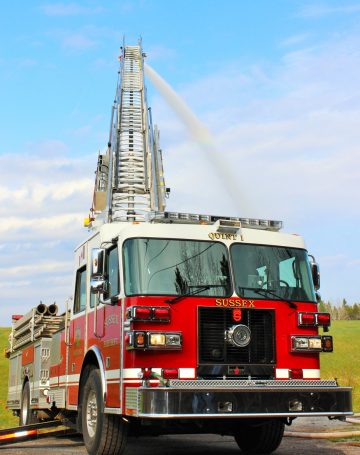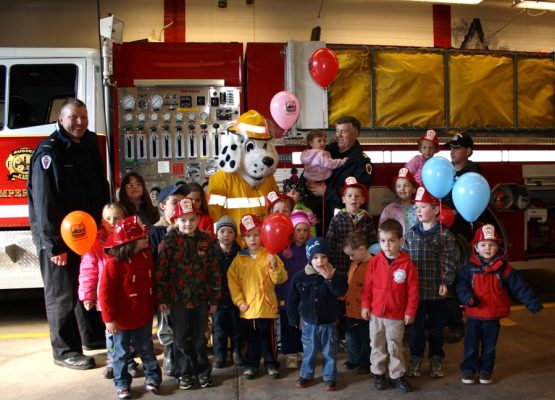The Sussex Fire Department has a very active Fire Prevention Committee. The committee’s main focus is on school programs for ages K to 3 where we feel Fire Prevention makes the biggest impact on kids in these age groups. We believe teaching kids at an early age is the foundation on practicing Fire Prevention through their lives. Kids are an excellent tool in educating their parents and other family member about fire safety.
The school program involves members holding assemblies at 4 area elementary schools teaching fire safety. The department sends home a smoke alarm survey and fire escape planning questionnaire to fill out with their parents. The surveys are returned to their schools where the fire department picks them up and enters them into the fire chief for the day contest. The 13 winners get to enjoy a saturday morning with firefighters including a breakfast, tour, education topic and knocking down targets using a hose line.
The committee also visits local senior homes for saftey talks and holds annual fire drills to help keep seniors sharp on escaping safely in case of a fire.
The department also partakes in the national kick off to fire prevention through Canadian Tire along with an open house at the fire station during Fire Prevention week. We also visit local day cares.
Tips for Fire Safety
- Minimum of 1 working smoke detector per floor
- Test your smoke detectors on a frequent basis and change the batteries
- Install a Co2 detector to prevent carbon monoxide poisoning
- Make sure you have a fire extinguisher and know how it works
- Every home should have a fire escape plan and practise it
- Keep your chimney and stove pipes clean to eliminate flue fires.
- Change your clock – Change your battery!
Handy Checklist of things to do in case of a FIRE!
- SMOKE ALARMS – Smoke alarms are you best warning. They will buy you time to make your escape.
- TWO WAYS OUT – Every room should have two ways out: the door and a window. Make sure the window is not blocked by furniture and is easily opened. If you live in a 2-story home, a roll-up fire escape ladder is a must for each bedroom on the upper floor.
- GET OUT FAST – One the alarm has sounded, do not stop to dress or gather valuables. Don’t let children look for favorite toys or even the family pet. Fire moves FAST.
- NEVER HIDE – When people see smoke or fire they often respond by trying to hide under the bed or in the closet. Remember, you cannot hide from fire but you can escape.
- TEST DOORS BEFORE OPENING THEM – Feel the door and look for smoke seeping in around the edges. Open it slowly and be prepared to slam it shut if heat and smoke rush in. If the door is hot, DON’T OPEN IT.
- CRAWL – If there is a lot of smoke, drop down on your hands and knees and crawl low under the smoke to the nearest exit. Smoke rises, so cleaner, cooler air is near the floor
- AN OUTSIDE MEETING PLACE – should be decided upon in advance. Locate a meeting place well away from the house and make a rule: ONCE OUT…STAY OUT – NEVER return to a burning building. A good meeting place would be a tree, a streetlight or a neighbour’s home. If someone is missing do not go back inside, notify responding fire fighters.
- LOTS OF PRACTICE – Rehearsing your escape plan regularly is essential. A practiced routine will override panic in an emergency situation. People who have had fire drill practice at home will automatically do the right thing in a real emergency.

